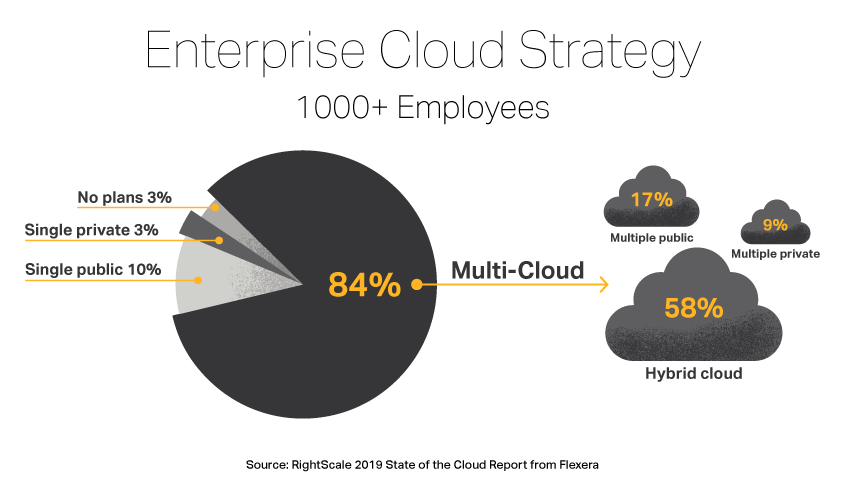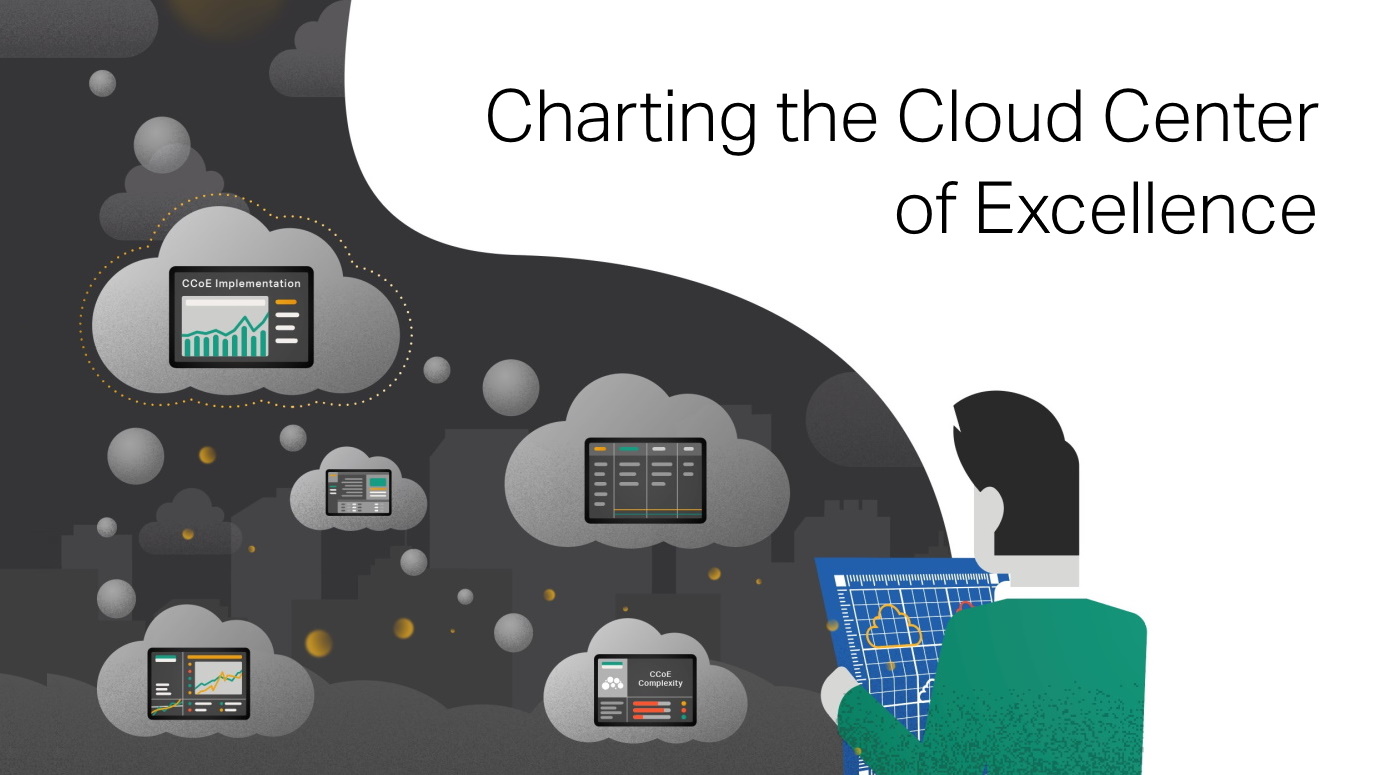
Today, a well-considered cloud strategy is an important prerequisite for your company's digital transformation. Let us introduce you to the basic types of cloud solutions before you decide on what path to choose and what technology to adopt.
Digital transformation is a must for your company in order to maintain and accelerate your business. The digital transformation is an ongoing journey that requires a strong strategy, in which case cloud solutions become very relevant. Needless to say, the cloud is not a specific location but rather an important tool to accelerate the transformation process.
When looking at customer usage of cloud we can distinguish four different types of clouds:
• Private cloud
• Public cloud
• Hybrid cloud
• Multiple public clouds
It is important to note that these cloud types apply mainly to your internal infrastructure and your business applications rather than the actual use of the cloud services such as Microsoft Office 365 or G Suite from Google. First, let's have a closer look at what each cloud type represents.
Private cloud
This is where your services and environments are placed in your own data centre or with a hosting partner. This solution normally requires specific on-premise software such as Azure Stack, VMware, vSphere, OpenStack, Kubernetes, Google Cloud Anthos, AWS Outposts or similar to realize the cloud model.
Which provider you ultimately choose depends on your chosen cloud strategy and whether it must be a private cloud placed on a shared infrastructure or a provider where you choose a dedicated solution. Consult an expert to hear more about the advantages and disadvantages.
Public cloud
This is the term for a solution where you place all your services and applications with one cloud provider. In other words, you have no on-premise resources or resources with a service provider, so the choice will often be AWS, Azure or Google Cloud.
Hybrid cloud
You can use the hybrid cloud if you place your services and applications with one cloud provider, but also have internal resources or resources with other cloud providers. The distribution of your workloads is secondary - you can have 90 percent of your workloads placed in a public cloud and 10 percent on-premise or vice versa.
Likewise, your production can be on-premise or in a public cloud. Either way, it is a hybrid cloud.
Multiple public cloud
Multiple public clouds occur when you have environments with more than one cloud provider. You might also have resources on-premise or with other service providers, but the main thing is that you have resources with more than one public cloud provider.
It is important to note here that some organisations would consider other cloud providers than Microsoft, AWS or Google. At the end of the day, the decision is up to your management team what you choose and what you define as cloud providers.
Now, let’s have a look at the current state of cloud usage for the corresponding strategies. With the survey of +1.000 FTE companies, the annual RightScale State of the Cloud Report showed that the use of multi-cloud strategies is far more widespread than public and private clouds among enterprises.

So far we have discussed multiple public clouds and not multi-cloud. As mentioned, more than one of the major cloud providers is used under the multiple public clouds model. On the other hand, multi-cloud can be both multiple private clouds, multiple public clouds and hybrid clouds combined.
Therefore, the question is whether you should choose a single public cloud model, a hybrid cloud model or a multi-cloud model. The figures from RightScale (see the diagram above) point to the hybrid cloud model but there may also be advantages with the two others. First and foremost, it must be a well-considered decision that suits your company and not the result of wanting to follow a trend. Let's take a closer look at the advantages of the three basic strategies.
The single cloud model
Here, you choose one single cloud provider for your entire solution. There's nothing wrong in that. Some companies fear lock-in, but that is only partly justified. Even though you have chosen the hybrid or multiple public cloud model, the workloads that are placed in the relevant cloud will always be locked to a certain extent.
Migration requires time, planning and resources no matter what. With this model you can create a strong partnership with your cloud provider and use it to accelerate your business further. Regardless of whether you collaborate with a Managed Service Provider (MSP) or not you can gain a high level of expertise that allows you to innovate.
The primary cloud providers have reached a level where they offer the majority of popular services which companies use. If a provider meets your needs, a single cloud model may be the right choice for you. Moreover, you can at any time start purchasing services from other cloud providers and change your strategy from single cloud to multiple clouds.
The multiple cloud model
There are some good reasons to choose the multiple clouds model. One of the most compelling is that you are not tied to one cloud provider. Imagine a scenario where you are not tied at all and where you have a workload that spans multiple cloud providers. It is possible, but often difficult to achieve.
In such a scenario, besides making sure that your workload spans across multiple clouds, you must also ensure that you do it for the entire network for the relevant workload and management (monitoring, security, backup, etc.). There are tools and services that offer some unification and abstraction of clouds but there are also downsides in using them. In many cases you cannot take advantage of specific features of certain cloud services, thus losing the opportunity to innovate and accelerate your business. The effort that you put into designing, architecting, maintaining and managing that workload might significantly exceed your budget.
The second most compelling reason for this strategy is that you can have workloads in locations that are covered only by one of your cloud providers. This is certainly a very valid reason where things like latency is critical. Naturally course, this is most often the case for global organizations. In global organizations you can also see where different departments reside in different countries or regions and that might result in those using different cloud providers depending on the region or other classification.
The hybrid cloud model
This is, by far, the most common cloud strategy. One of the reasons for this is that many companies have started out with on-premise workloads and have used that as a starting point for cloud-migration. It can also be due to compliance requirements, legacy software, cost efficiency, etc.
If you look at any of the primary cloud providers and many third-party software developers, you will discover that they offer to combine cloud and on-premise resources in a way that makes it easier to manage, take backups, etc. Naturally, the experience is always the best when the cloud provider of your choice also provides most of the software you use on-premise.
The hybrid cloud model is also about flexibility. To move everything out into a cloud is no easy matter and definitely not something you do overnight. For companies that migrate or are about to migrate, the hybrid cloud is often the right choice. This provides the option to progress at your own pace, but still takes advantage of all the good benefits of the cloud. In addition, it provides the option to re-architect some of your operations by re-thinking how you attend to monitoring, backup & disaster recovery, release management, etc.
Summary
It is worth considering all three cloud models but there is only one that suits your company 100 percent. To choose the model that best meets your business needs, you will need to map your entire organisation and have a clear picture of your objectives and your resources. In addition, you must have the flexibility to switch from one model to another if the need arises. But above all: Choose correctly the first time so you can take advantage of the cloud to advance your digital transformation.



